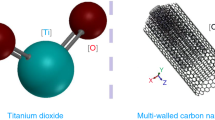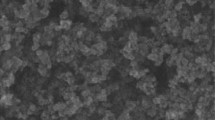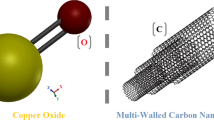Abstract
In this study, an experimental study on the effect of temperature and particles concentration on the dynamic viscosity of MWCNT-OH and their composites with Ag, Au and Pd in water, ethylene glycol and ethylene glycol/water (60:40 vol%) is presented. The experiments were carried out in the solid weight fraction range of 0.0125–0.1 under the temperature range from 10 to 40 °C. The results show that the nanofluids behave as a Newtonian fluid for all solid mass fractions and temperatures considered. In addition, the dynamic viscosity increases with increasing the solid mass fraction and decreases with the temperature rising. Additionally, the performance of the artificial neural network (ANN) based on back propagation training with 20 neurons in hidden layer for predicting of behavior of above mention nanofluids was investigated. The AAD% of a collection of 192 data points for all nanofluids using the ANN at various temperatures, solid mass fractions, viscosity of based fluids, molar mass of based fluids and diameter of nanoparticles is 0.98%.



















Similar content being viewed by others
Abbreviations
- nf:
-
Nanofluid
- bf:
-
Base fluid
- ANN:
-
Artificial neural network
- MLP:
-
Multilayer perceptron
- MSE:
-
Mean square error
- AAD:
-
Absolute average deviation
- MARE:
-
Mean average relative error
- R 2 :
-
Coefficient of determination
- W :
-
Weight
- b :
-
Bias
- Rel:
-
Relative
- Exp:
-
Experimental
- MWCNT:
-
Multiwalled carbon nanotube
- T :
-
Temperature (°C)
- k :
-
Thermal conductivity (W mK−1)
- d :
-
Size of nanoparticle (nm)
- Wm:
-
Molar mass (g mol−1)
- ρ :
-
Density (g cm−3)
- φ :
-
Solid mass fraction (mass%)
- τ :
-
Shear stress(dyne cm−2)
- µ :
-
Viscosity (mP s)
References
Anoop KB, Kabelac S, Sundararajan T, Das SK. Rheological and flow characteristics of nanofluids; influence of electro viscous effects and particle agglomeration. J Appl Phys. 2009;106:034909.
Nguyen CT, Desgranges F, Roy G, Galanis N, Mare T, Boucher S. Temperature and particle-size dependent viscosity data for water-based nanofluids—hysteresis phenomenon. Int J Heat Fluid Flow. 2007;28:1492–506.
Kavitha T, Rajendran AD. Heat transfer enhancement using nanofluids and innovative methods—an overview. Int J Mech Eng Res Tech. 2012;3:769–82.
Pak BC, Cho YI. Hydrodynamic and heat transfer study of dispersed fluids with submicron metallic oxide particles. Exp Heat Transf. 1998;11:151–70.
Esfe MH, Saedodin S, Asadi A, Karimpour A. Thermal conductivity and viscosity of Mg(OH)2-ethylen glycol nanofluid. J Therm Anal Calorim. 2015;120:1145–9.
Zyla G. Viscosity and thermal conductivity of MgO–EG nanofluids. Experimental results and theoretical models predictions. J Therm Anal Calorim. 2017;129:171–80.
Esfe MH, Saedodin S, Wongwises S, Toghraie D. An experimental study on the effect of diameter on thermal conductivity and dynamic viscosity of Fe/water nanofluids. J Therm Anal Calorim. 2015;119:1817–24.
Abasi S, Zebarjad SM, Noie Baghban SH, Youssefi F, Ekrami-Kakhk MS. Experimental investigation of the rheological behavior and viscosity of decorated multi-walled carbon nanotubes with TiO2 nanoparticle/water nanofluid. J Therm Anal Calorim. 2016;123:81–9.
Chen H, Yang W, He Y, Ding Y, Zhang L, Tan C, Lapkin AA, Bavykin DV. Heat transfer and flow behaviour of aqueous suspensions of titanate nanotubes (nanofluids). Powder Tech. 2008;183:63–72.
Kole M, Dey TK. Effect of aggregation on the viscosity of copper oxide-gear oil nanofluids. Int J Therm Sci. 2011;50:1741–7.
Garg P, Jorge LA, Marsh C, Carlson TA, Kessler DA, Annamalai K. An experimental study on the effect of ultra -sonication on viscosity and heat transfer performance of multi-wall carbon nanotube based aqueous nanofluids. Int J Heat Mass Transf. 2009;52:5090–8.
Yang Y, Grulke EA, Zhanh ZG, Wu G. Thermal and rheological properties of carbon nanotube-in-oil dispersions. J Appl Phys. 2006;99:114307–8.
Kanagaraj S, Varabda FR, Fonseca A, Ponmozhi J, Lopez da Silva JA, Oliveira MSA. Rheological study of nanofluids at different concentration of carbon nanotubes. In: 19th National and 8th ISHMT-ASME Heat Mass Transfer Conference, 3–5 January 2008. Hyderabad, India (paper NFF-7).
Nguyen CT, Roy G, Gauthier C, Galanis N. Heat transfer enhancement using AL2O3-water nanofluid for an electronic liquid cooling system. Appl Therm Eng. 2007;27:1501–6.
Peyghambarzadeh SM, Hashemabadi SH, Naraki M, Vermahmoudi Y. Experimental study of overall heat transfer coefficient in the application of dilute nanofluids in the car radiator. Appl Therm Eng. 2013;52:52–8.
Azmi WH, Hamid KA, Mamat R, Sharma KV, Mohamad MS. Effects of working temperature on thermo-physical properties and forced convection heat transfer of TiO2 nanofluids in water–ethylene glycol mixture. J Appl Therm Eng. 2016;106:1190–9.
Sundar LS, Ramana EV, Singh MK, De Sousa ACM. Viscosity of low volume concentrations of magnetic Fe3O4 nanoparticles dispersed in ethylene glycol and water mixture. J Chem Phys Lett. 2012;554:236–42.
Wang B, Wang X, Lou W, Hao J. Thermal conductivity and rheological properties of graphite/oil nanofluids. Colloids Surf Physicochem Eng Asp. 2012;414:125–31.
Madhusree K, Dey TK. Effect of aggregation on the viscosity of copper oxide-gear oil nanofluids. Int J Therm Sci. 2011;50:1741–7.
Madhusree K, Dey TK. Enhanced thermophysical properties of copper nanoparticles dispersed in gear oil. Appl Therm Eng. 2013;56:45–53.
Einstein A. Einene uebestimmung der molekul dimensionen. Ann Phys. 1906;19:289–306.
Batchelor GK. The effect of Brownian motion on the bulk stress in the suspension of spherical particles. J Fluid Mech. 1977;83:97–117.
Masoumi N, Sohrabi N, Behzadmehr A. A new model for calculating the effective viscosity of nanofluids. J Phys D Appl Phys. 2009;42:055501–6.
Hosseini MS, Mohebbi A, Ghader S. Correlation of shear viscosity of nanofluids using the local composition theory. Chin J Chem Eng. 2010;18:102–7.
Nguyen CT, Desgranges F, Galanis N, Roy G, Mare T, Boucher S, Mintsa HA. Viscosity data for Al2O3–water nanofluid-hysteresis: is heat transfer enhancement using nanofluids reliable. Int J Therm Sci. 2008;47:103–292.
Maiga SEB, Nguyen CT, Galanis N, Roy G. Heat transfer behaviors of nanofluids in a uniformly heated tube. Super Lattices Microstruct. 2004;35:543–57.
Kulkarni DP, Das DK, Chukwu G. Temperature dependent rheological property of copper oxide nanoparticles suspension (Nanofluid). J Nanosci Nanotechnol. 2006;6:1150–4.
Yousefi F, Karimi H, Gomar M. Ability of analytical and artificial approaches for prediction of the volumetric properties of some polymer blends. Fluid Phase Equilib. 2013;355:92–8.
Yousefi F, Karimi H. Application of equation of state and artificial neural network to prediction of volumetric properties of polymer melts. J Ind Eng Chem. 2013;19:498–507.
Yousefi F, Karimi H. P–V–T properties of polymer melts based on equation of state and neural network. Eur Polym J. 2012;48:1135–43.
Yousefi F, Karimi H, Gandomkar Z. Equation of state and artificial neural network to predict the thermodynamic properties of pure and mixture of liquid alkali metals. Fluid Phase Equilib. 2014;370:43–9.
Yousefi F, Karimi H, Alekasir E, Shishebor M. Prediction of thermodynamic behavior of copolymers using equation of state and artificial neural network. Colloid Polym Sci. 2015;293:75–7.
Yousefi F, Mohammadiyan S, Karimi H. Application of artificial neural network and PCA to predict the thermal conductivities of nanofluids. Heat Mass Transf. 2016;52:2141–54.
Yousefi F, Karimi H, Mohammadiyan S. Viscosity of carbon nanotube suspension using artificial neural networks with principal component analysis. Heat Mass Transf. 2016;52:2345–55.
Yousefi F, Amoozandeh Z. Statistical mechanics and artificial intelligence to model the thermodynamic properties of pure and mixture of ionic liquids. Chin J Chem Eng. 2016;24:1761–71.
Ghaedi A. Simultaneous prediction of the thermodynamic properties of aqueous solution of ethylene glycol monoethyl ether using artificial neural network. J Mol Liq. 2015;207:327–33.
Alirezaie A, Saedodin S, Esfe MH, Rostamian SH. Investigation of rheological behavior of MWCNT (COOH-functionalized)/MgO-Engine oil hybrid nanofluids and modelling the results with artificial neural networks. J Mol Liq. 2017;241:173–81.
Hemmat Esfe M, Rostamian H. Rheological behavior characteristics of ZrO2-MWCNT/10w40 hybrid nano-lubricant affected by temperature, concentration, and shear rate: an experimental study and a neural network simulating. Physica E. 2017. https://doi.org/10.1016/j.physe.2017.12.023.
Hemmat Esfe M, Rostamian H, Sarlak MR, Rejvani M, Alirezaie A. Rheological behavior characteristics of TiO2-MWCNT/10w40 hybrid nano-oil affected by temperature, concentration and shear rate: an experimental study and a neural network simulating. Physica E. 2017;94:231–40.
Aghaei A, Khorasanizadeh H, Sheikhzadeh GA. Measurement of the dynamic viscosity of hybrid engine oil -Cuo-MWCNT nanofluid, development of a practical viscosity correlation and utilizing the artificial neural network. Heat Mass Transfer. 2018. https://doi.org/10.1007/s00231-017-2112-6.
Aminian A. Predicting the effective viscosity of nanofluids for the augmentation of heat transfer in the process industries. J Mol Liq. 2017;229:300–8.
Abdollahi Moghaddam M, Motahari K. Experimental investigation, sensitivity analysis and modeling of rheological behavior of MWCNT-CuO (30–70)/SAE40 hybrid nano-lubricant. Appl Therm Eng. 2017;123:1419–33.
Hemmat Esfe M, Zabihi F, Rostamian H, Esfandeh S. Experimental investigation and model development of the non-Newtonian behavior of CuO-MWCNT-10w40 hybrid nano-lubricant for lubrication purposes. J Mol Liq. 2018;249:677.
Timofeeva EV, Yu W, France DM, Singh D, Routbort JL. Base fluid and temperature effects on the heat transfer characteristics of SiC in ethylene glycol/H2O and H2O nanofluids. J Appl Phys. 2011;109:014914.
Messikha N, Bousbaab S, Bougdah N. The use of a multilayer perceptron (MLP) for modelling the phenol removal by emulsion liquid membrane. J Environ Chem Eng. 2017;5(4):3483.
Author information
Authors and Affiliations
Corresponding author
Rights and permissions
About this article
Cite this article
Moghaddari, M., Yousefi, F. Syntheses, characterization, measurement and modeling viscosity of nanofluids containing OH-functionalized MWCNTs and their composites with soft metal (Ag, Au and Pd) in water, ethylene glycol and water/ethylene glycol mixture. J Therm Anal Calorim 135, 83–96 (2019). https://doi.org/10.1007/s10973-018-7150-x
Received:
Accepted:
Published:
Issue Date:
DOI: https://doi.org/10.1007/s10973-018-7150-x




